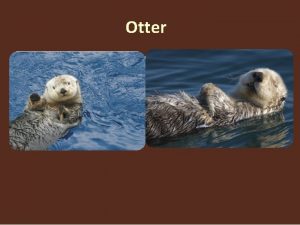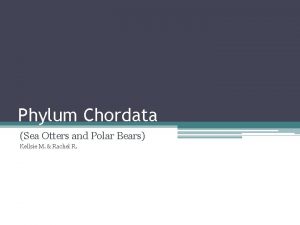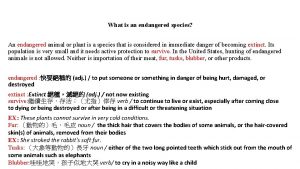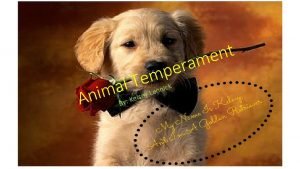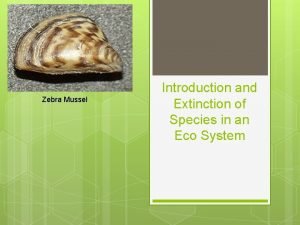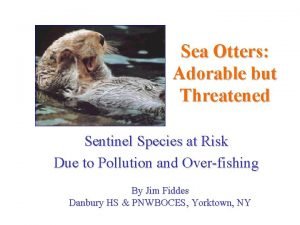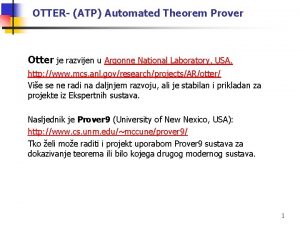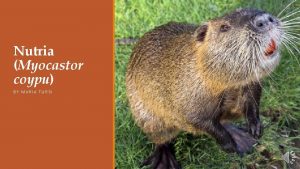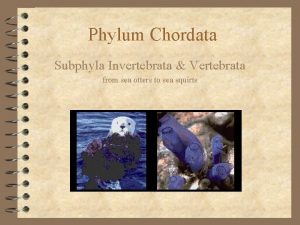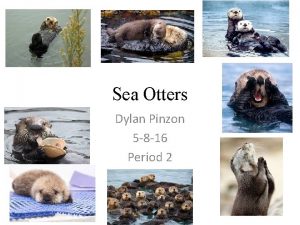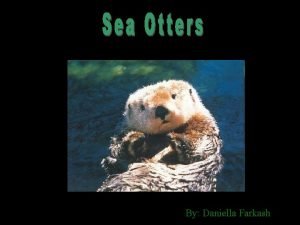Otter Otters are semiaquatic or in one case
















- Slides: 16

Otter

• Otters are semi-aquatic (or in one case aquatic) fish-eating mammals. The otter subfamily Lutrinae forms part of the family Mustelidae, which also includes weasels, polecats, badgers, as well as others.

Food • With twelve species in seven genera, otters have an almost worldwide distribution. • They mainly eat aquatic animals, fish and shellfish, but also birds, frogs, crayfish, crabs and small mammals.

• For most otters, fish is the primary staple of their diet. • Some otters are expert at opening shellfish, and others will feed on available small mammals or birds.

Gestation • The time of gestation of otters is about 60 to 86 days. The newborn baby is taken care of by the mother, the father, and all the other offspring. • Female otters reach sexual maturity at approximately 2 years of age, while males can produce offspring at approximately 3 years of age.

• After one month, the young otter can come out of the cave, and after 2 months it is able to swim. • It lives with its family for about 1 year so that it can learn and be kept safe until maturity. Otters live up to 10 years.

Characteristics • Otters have long, slim bodies and relatively short limbs, with webbed paws. Most have sharp claws on their feet, and all except the sea otter have long muscular tails.

• The twelve species range in adult size from 0. 7 to 1. 8 metres (2 to 6 feet) in length and 5 to 45 kilograms (10 to 100 pounds) in weight.

• They have a very soft, insulated underfur which is protected by their outer layer of long guard hair. Their fur keeps them dry and warm under water. • Many otters live in cold waters and have very high metabolic rates to help keep them warm.

• Because of their beautiful fur, some people are still hunting otters and buying clothes and shoes that are made of otter fur.

• Sea Otter Fur Trade

• Sea otters can do well in captivity, and are featured in over 40 public aquariums and zoos.

Videos • http: //www. youtube. com/watch? v=BQLQh. Z-YO_s&NR=1 (Celebrity otters - otters holding hands - otter video) – almost 15. ooo wievs • http: //www. youtube. com/watch? v=Ghuva. KLJb. Nw&NR=1 (baby otters) • http: //www. youtube. com/watch? v=a. UJDm. AXs. Evs (noisy otters in Zoos) • http: //www. youtube. com/watch? v=1 NQq. Oi. GTUWw&NR=1

Sources • • • http: //en. wikipedia. org/wiki/Otter http: //www. otterjoy. com/otterholdings. html http: //www. google. si/imgres? imgurl=http: //upload. wikimedia. org/ http: //www. youtube. com/ Google pictures


The end
 Insidan region jh
Insidan region jh Otters are semi aquatic
Otters are semi aquatic Sea and marine otters belong to the order carnivora.
Sea and marine otters belong to the order carnivora. Otter personality test
Otter personality test Polar bear phylum
Polar bear phylum Sea otters extinct
Sea otters extinct Best case worst case average case
Best case worst case average case Otter creek institute
Otter creek institute Lion otter beaver golden retriever
Lion otter beaver golden retriever Lion otter beaver golden retriever
Lion otter beaver golden retriever Lion otter beaver golden retriever
Lion otter beaver golden retriever Lion otter beaver golden retriever personality test
Lion otter beaver golden retriever personality test The dinosaur and the dodo bird
The dinosaur and the dodo bird Sea otter endangered species
Sea otter endangered species Martin otter
Martin otter Peaks of otter
Peaks of otter Sea otter population decline
Sea otter population decline

